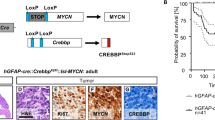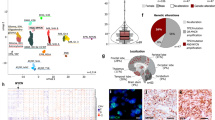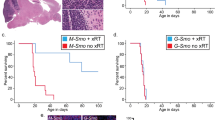Abstract
Primitive neuroectodermal tumors (PNETs) are a family of primary malignant brain tumors that include medulloblastomas. Although genetic models of a subset of medulloblastomas are documented over the past decade, the molecular basis of other subclasses of PNET remains unclear. As elevated c-Myc expression, activation of Wnt/β-catenin signaling and dysfunction of p53 are seen in human PNETs, we investigated what role these abnormalities have in the formation of PNETs. Incorporating these abnormalities, we generated supratentorial PNET (sPNET) in mice using somatic cell gene transfer. We show that sPNETs arise from GFAP-expressing cells by forced c-Myc expression combined with p53 inactivation. β-catenin activation promotes tumor progression and induces divergent differentiation. These c-Myc+β-catenin-induced PNETs are histologically similar to large cell/anaplastic medulloblastomas and can occur in both cerebrum and cerebellum. Furthermore, we have obtained one PNET with marked epithelial differentiation having histological resemblance to choroid plexus carcinoma in this series. Our results in mice suggest that sPNET with varied differentiation and large cell/anaplastic medulloblastomas may be two tumor groups with similar genetic foundations. These data provide insights into the biology and classification of human PNETs and suggest that multiple tumor types or variants can be generated from a fixed set of genetic abnormalities.
This is a preview of subscription content, access via your institution
Access options
Subscribe to this journal
Receive 50 print issues and online access
$259.00 per year
only $5.18 per issue
Buy this article
- Purchase on Springer Link
- Instant access to full article PDF
Prices may be subject to local taxes which are calculated during checkout






Similar content being viewed by others

References
Adesina AM, Nalbantoglu J, Cavenee WK . (1994). p53 gene mutation and mdm2 gene amplification are uncommon in medulloblastoma. Cancer Res 54: 5649–5651.
Anwer UE, Smith TW, DeGirolami U, Wilkinson HA . (1989). Medulloblastoma with cartilaginous differentiation. Arch Pathol Lab Med 113: 84–88.
Brown HG, Kepner JL, Perlman EJ, Friedman HS, Strother DR, Duffner PK et al. (2000). ‘Large cell/anaplastic’ medulloblastomas: a Pediatric Oncology Group Study. J Neuropathol Exp Neurol 59: 857–865.
Carlotti Jr CG, Neder L, Colli BO, dos Santos MB, Garcia AS, Elias Jr J et al. (2002). Evaluation of proliferative index and cell cycle protein expression in choroid plexus tumors in children. Acta Neuropathol (Berl) 103: 1–10.
Dai C, Celestino JC, Okada Y, Louis DN, Fuller GN, Holland EC . (2001). PDGF autocrine stimulation dedifferentiates cultured astrocytes and induces oligodendrogliomas and oligoastrocytomas from neural progenitors and astrocytes in vivo. Genes Dev 15: 1913–1925.
Eberhart CG, Chaudhry A, Daniel RW, Khaki L, Shah KV, Gravitt PE . (2005). Increased p53 immunopositivity in anaplastic medulloblastoma and supratentorial PNET is not caused by JC virus. BMC Cancer 5: 19.
Eberhart CG, Kepner JL, Goldthwaite PT, Kun LE, Duffner PK, Friedman HS et al. (2002). Histopathologic grading of medulloblastomas: a Pediatric Oncology Group study. Cancer 94: 552–560.
Frank AJ, Hernan R, Hollander A, Lindsey JC, Lusher ME, Fuller CE et al. (2004). The TP53-ARF tumor suppressor pathway is frequently disrupted in large/cell anaplastic medulloblastoma. Brain Res Mol Brain Res 121: 137–140.
Fults D, Pedone C, Dai C, Holland EC . (2002). MYC expression promotes the proliferation of neural progenitor cells in culture and in vivo. Neoplasia 4: 32–39.
Gessi M, Giangaspero F, Pietsch T . (2003). Atypical teratoid/rhabdoid tumors and choroid plexus tumors: when genetics ‘surprise’ pathology. Brain Pathol 13: 409–414.
Goodrich LV, Milenkovic L, Higgins KM, Scott MP . (1997). Altered neural cell fates and medulloblastoma in mouse patched mutants. Science 277: 1109–1113.
Green DR, Evan GI . (2002). A matter of life and death. Cancer Cell 1: 19–30.
He TC, Sparks AB, Rago C, Hermeking H, Zawel L, da Costa LT et al. (1998). Identification of c-MYC as a target of the APC pathway. Science 281: 1509–1512.
Hill TP, Spater D, Taketo MM, Birchmeier W, Hartmann C . (2005). Canonical Wnt/beta-catenin signaling prevents osteoblasts from differentiating into chondrocytes. Dev Cell 8: 727–738.
Ho YS, Hsieh LL, Chen JS, Chang CN, Lee ST, Chiu LL et al. (1996). p53 gene mutation in cerebral primitive neuroectodermal tumor in Taiwan. Cancer Lett 104: 103–113.
Holland EC, Celestino J, Dai C, Schaefer L, Sawaya RE, Fuller GN . (2000). Combined activation of Ras and Akt in neural progenitors induces glioblastoma formation in mice. Nat Genet 25: 55–57.
Holland EC, Hively WP, DePinho RA, Varmus HE . (1998). A constitutively active epidermal growth factor receptor cooperates with disruption of G1 cell-cycle arrest pathways to induce glioma-like lesions in mice. Genes Dev 12: 3675–3685.
Jacks T, Remington L, Williams BO, Schmitt EM, Halachmi S, Bronson RT et al. (1994). Tumor spectrum analysis in p53-mutant mice. Curr Biol 4: 1–7.
Janzer RC, Kleihues P . (1985). Primitive neuroectodermal tumor with choroid plexus differentiation. Clin Neuropathol 4: 93–98.
Jay V, Ho M, Chan F, Malkin D . (1996). P53 expression in choroid plexus neoplasms: an immunohistochemical study. Arch Pathol Lab Med 120: 1061–1065.
Koch A, Waha A, Tonn JC, Sorensen N, Berthold F, Wolter M et al. (2001). Somatic mutations of WNT/wingless signaling pathway components in primitive neuroectodermal tumors. Int J Cancer 93: 445–449.
Kratz JE, Stearns D, Huso DL, Slunt HH, Price DL, Borchelt DR et al. (2002). Expression of stabilized beta-catenin in differentiated neurons of transgenic mice does not result in tumor formation. BMC Cancer 2: 33.
Kraus JA, Felsberg J, Tonn JC, Reifenberger G, Pietsch T . (2002). Molecular genetic analysis of the TP53, PTEN, CDKN2A, EGFR, CDK4 and MDM2 tumour-associated genes in supratentorial primitive neuroectodermal tumours and glioblastomas of childhood. Neuropathol Appl Neurobiol 28: 325–333.
Leonard JR, Cai DX, Rivet DJ, Kaufman BA, Park TS, Levy BK . (2001). Perry Large cell/anaplastic medulloblastomas and medullomyoblastomas: clinicopathological and genetic features. J Neurosurg 95: 82–88.
Louis DN, Ohgaki H, Wiestler OD, Cavenee WK, Burger PC, Jouvet A et al. (2007). The 2007 WHO classification of tumours of the central nervous system. Acta Neuropathol 114: 97–109 (Review). Erratum in: Acta Neuropathol (2007) November; 114: 547.
Marino S, Vooijs M, van Der Gulden H, Jonkers J, Berns A . (2000). Induction of medulloblastomas in p53-null mutant mice by somatic inactivation of Rb in the external granular layer cells of the cerebellum. Genes Dev 14: 994–1004.
McCall TD, Pedone CA, Fults DW . (2007). Apoptosis suppression by somatic cell transfer of Bcl-2 promotes Sonic hedgehog-dependent medulloblastoma formation in mice. Cancer Res 67: 5179–5185.
Ohgaki H, Eibl RH, Schwab M, Reichel MB, Mariani L, Gehring M et al. (1993). Mutations of the p53 tumor suppressor gene in neoplasms of the human nervous system. Mol Carcinog 8: 74–80.
Pauklin S, Kristjuhan A, Maimets T, Jaks V . (2005). ARF and ATM/ATR cooperate in p53-mediated apoptosis upon oncogenic stress. Biochem Biophys Res Commun 334: 386–394.
Pillai A, Rajeev K, Chandi S, Unnikrishnan M . (2004). Intrinsic brainstem choroid plexus papilloma. Case report. J Neurosurg 100: 1076–1078.
Rao G, Pedone CA, Coffin CM, Holland EC, Fults DW . (2003). c-Myc enhances sonic hedgehog-induced medulloblastoma formation from nestin-expressing neural progenitors in mice. Neoplasia 5: 198–204.
Reifenberger J, Janssen G, Weber RG, Bostrom J, Engelbrecht V, Lichter P et al. (1998). Primitive neuroectodermal tumors of the cerebral hemispheres in two siblings with TP53 germline mutation. J Neuropathol Exp Neurol 57: 179–187.
Rostomily RC, Bermingham-McDonogh O, Berger MS, Tapscott SJ, Reh TA, Olson JM . (1997). Expression of neurogenic basic helix-loop-helix genes in primitive neuroectodermal tumors. Cancer Res 57: 3526–3531.
Russo C, Pellarin M, Tingby O, Bollen AW, Lamborn KR, Mohapatra G et al. (1999). Comparative genomic hybridization in patients with supratentorial and infratentorial primitive neuroectodermal tumors. Cancer 86: 331–339.
Saylors III RL, Sidransky D, Friedman HS, Bigner SH, Bigner DD, Vogelstein B et al. (1991). Infrequent p53 gene mutations in medulloblastomas. Cancer Res 51: 4721–4723.
Sevenet N, Lellouch-Tubiana A, Schofield D, Hoang-Xuan K, Gessler M, Birnbaum D et al. (1999). Spectrum of hSNF5/INI1 somatic mutations in human cancer and genotype-phenotype correlations. Hum Mol Genet 8: 2359–2368.
Shakhova O, Leung C, van Montfort E, Berns A, Marino S . (2006). Lack of Rb and p53 delays cerebellar development and predisposes to large cell anaplastic medulloblastoma through amplification of N-Myc and Ptch2. Cancer Res 66: 5190–5200.
Su X, Gopalakrishnan V, Stearns D, Aldape K, Lang FF, Fuller G et al. (2006). Abnormal expression of REST/NRSF and Myc in neural stem/progenitor cells causes cerebellar tumors by blocking neural differentiation. Mol Cell Biol 26: 1666–1678.
van de Wetering M, Sancho E, Verweij C, de Lau W, Oving I, Hurlstone A et al. (2002). The beta-catenin/TCF-4 complex imposes a crypt progenitor phenotype on colorectal cancer cells. Cell 111: 241–250.
Vital A, Bringuier PP, Huang H, San Galli F, Rivel J, Ansoborlo S et al. (1998). Astrocytomas and choroid plexus tumors in two families with identical p53 germline mutations. J Neuropathol Exp Neurol 57: 1061–1069.
Weiner HL, Bakst R, Hurlbert MS, Ruggiero J, Ahn E, Lee WS et al. (2002). Induction of medulloblastomas in mice by sonic hedgehog, independent of Gli1. Cancer Res 62: 6385–6389.
Wetmore C, Eberhart DE, Curran T . (2001). Loss of p53 but not ARF accelerates medulloblastoma in mice heterozygous for patched. Cancer Res 61: 513–516.
Yuasa H, Tokito S, Tokunaga M . (1993). Primary carcinoma of the choroid plexus in Li–Fraumeni syndrome. Neurosurgery 32: 131–134.
Acknowledgements
We thank Mark Rosenblum and Jason Huse for pathology expertise, Harold Varmus for RCAS-β-catenin, Daniel W Fults for RCAS-c-Myc, Margaret Leversha and Lei Zhang for assisting in the FISH analysis, Robert J Finney and Edward Nerio for histology assistance and mouse maintenance. This work was supported by NIH Grants RO1 CA099489 and RO1 CA100688 to EC Holland.
Author information
Authors and Affiliations
Corresponding author
Additional information
Supplementary Information accompanies the paper on the Oncogene website (http://www.nature.com/onc)
Supplementary information
Rights and permissions
About this article
Cite this article
Momota, H., Shih, A., Edgar, M. et al. c-Myc and β-catenin cooperate with loss of p53 to generate multiple members of the primitive neuroectodermal tumor family in mice. Oncogene 27, 4392–4401 (2008). https://doi.org/10.1038/onc.2008.81
Received:
Revised:
Accepted:
Published:
Issue Date:
DOI: https://doi.org/10.1038/onc.2008.81
Keywords
This article is cited by
-
Human pluripotent stem cell-derived brain organoids as in vitro models for studying neural disorders and cancer
Cell & Bioscience (2021)
-
Down-regulation of 14-3-3zeta reduces proliferation and increases apoptosis in human glioblastoma
Cancer Gene Therapy (2020)
-
Somatic cell transfer of c-Myc and Bcl-2 induces large-cell anaplastic medulloblastomas in mice
Journal of Neuro-Oncology (2016)
-
Wnt activation affects proliferation, invasiveness and radiosensitivity in medulloblastoma
Journal of Neuro-Oncology (2015)
-
The prenatal origins of cancer
Nature Reviews Cancer (2014)


